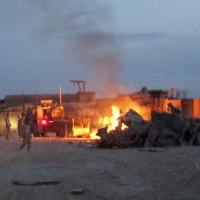U.S. Waste Disposal in Afghanistan: Unused Incinerators and Open-Air Burn Pits
 Open-air burn pit at an operating based near Kabul (photo: Simon Klingert, AP)
Open-air burn pit at an operating based near Kabul (photo: Simon Klingert, AP)
In spite of an $80-million investment in building incinerators for hazardous waste disposal in Afghanistan, the U.S. military left many of them unused, resulting in increased use of open-air burn pits whose dangerous fumes put thousands of soldiers and civilians at risk.
The repeated use by the U.S. military of burn pits to dispose of solid and hazardous wastes—from batteries, plastics and aerosol cans to tires and entire vehicles—was one of the foulest stories to come out of the Afghanistan war. The practice produced acrid smoke and exposed tens of thousands of soldiers and civilian personnel to toxic fumes that have been linked to serious health problems, including cancer, cardiopulmonary diseases and reduced lung function.
To address the problem and reduce exposure to military personnel, the Department of Defense (DOD) invested $81 million on 23 solid waste incineration systems for nine installations in Afghanistan. But at four military bases, eight of the incinerators either weren’t used or only partially used, according to an investigation (pdf) by John Sopko, the Special Inspector General for Afghanistan Reconstruction (SIGAR).
The four installations visited by SIGAR staff from 2012 to 2014 revealed serious mechanical problems with the costly incinerators, including leaking hydraulic lines, rusted equipment, and missing insulation. One operating base received its incinerators from the contractor two years late and, before even being used, requiring $1 million in repair work.
The inspectors also discovered that the incinerators had been too expensive to use—some of them cost a million dollars a year to operate.
These shortcomings resulted in base commanders deciding to continue to use the burn pits—some reported to be the size of three football fields—to help dispose of the 440 tons of waste produced each day at the peak of the war. Use of the pits continued at some bases until late 2013, despite the health risks of doing so—and despite being told by Congress to stop the practice.
“Unfortunately, in many instances DOD...officials did not take sufficient steps to ensure the proper management of contracts for the construction of the incinerators,” Sopko said in a letter to Defense Secretary Chuck Hagel.
“Given the fact that DOD has been aware for many years of the significant health risks associated with open-air burn pits, it is indefensible that U.S. military personnel, who are already at risk of serious injury and death when fighting the enemy, were put at further risk from the potentially harmful emissions,” Sopko said.
SIGAR claims that the military has been aware of the dangers of open-air burn pits since the 1970s and failed to impose controls on them for more than three decades. A SIGAR spokesman said it’s believed that there are no burn pits still in use in Afghanistan.
-Noel Brinkerhoff, Danny Biederman
To Learn More:
Final Assessment: What We Have Learned From Our Inspections of Incinerators and Use of Burn Pits in Afghanistan (Special Inspector General for Afghanistan Reconstruction) (pdf)
U.S. Troops Burned Waste in Hazardous Open Pits While Safer Incinerators Sat Idle (by Julia Harte, Center for Public Integrity)
Waste Disposal in Afghanistan: The Final Word (by Neil Gordon,Project on Government Oversight)
More U.S. Money to Burn in Afghanistan, This Time Millions on Faulty Incinerators (by Noel Brinkerhoff, AllGov)
The Faceless Enemy in Iraq and Afghanistan that Has Harmed U.S. Vets: Burn Pits (by Noel Brinkerhoff, AllGov)
- Top Stories
- Unusual News
- Where is the Money Going?
- Controversies
- U.S. and the World
- Appointments and Resignations
- Latest News
- Trump to Stop Deportations If…
- Trump Denounces World Series
- What If China Invaded the United States?
- Donald Trump Has a Mental Health Problem and It Has a Name
- Trump Goes on Renaming Frenzy






Comments